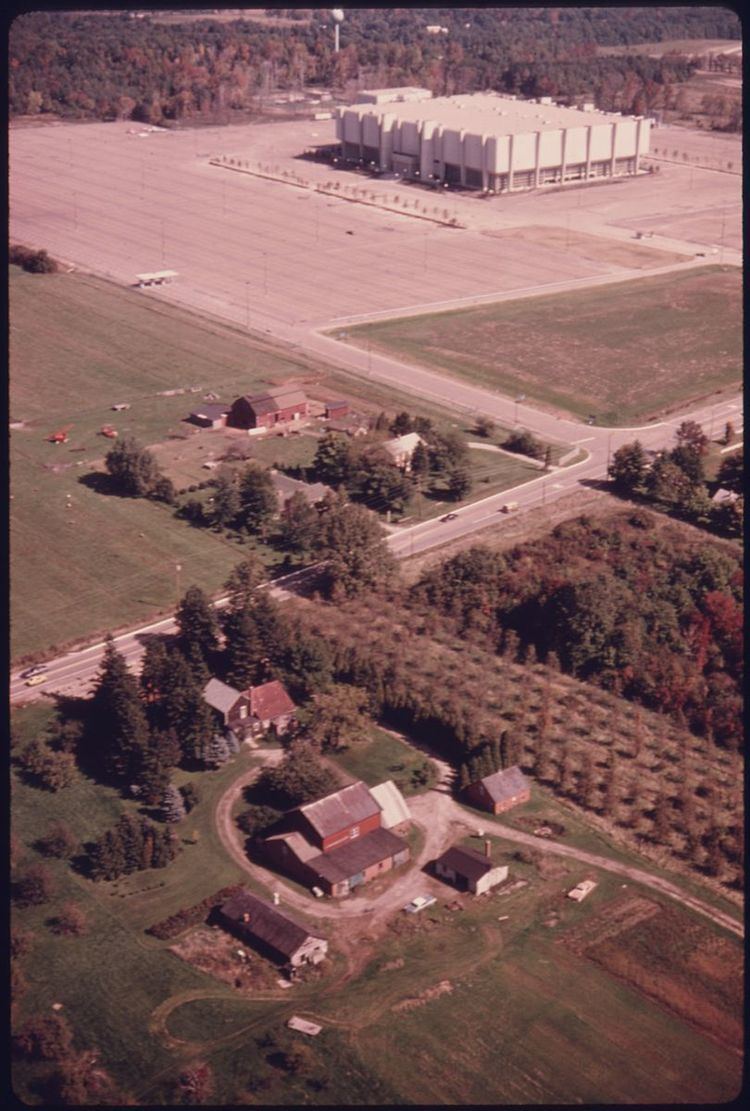Broke ground March 16, 1973 Opened 26 October 1974 | Closed September 24, 1994 Demolished 21 May 1999 | |
 | ||
Location 2923 Streetsboro RoadRichfield, Ohio 44286United States Owner Gund Business Enterprises, Inc. Operator Gund Business Enterprises, Inc. Capacity Basketball: 20,273Ice hockey: 18,544 Address 2923 W Streetsboro Rd, Richfield, OH 44286, USA Similar Capital Centre, McNichols Sports Arena, Cleveland Arena, Omni Coliseum, Market Square Arena | ||
Demolition of the richfield coliseum cleveland
Richfield Coliseum, also known as the Coliseum at Richfield, was an indoor arena located in Richfield Township, roughly halfway between Cleveland and Akron, Ohio. It opened in 1974 as a replacement for the Cleveland Arena, and had a seating capacity of 20,273 for basketball. It was the main arena for the Northeast Ohio region until 1994, when it was replaced by Quicken Loans Arena in downtown Cleveland. The Coliseum stood vacant for five years before it was purchased and razed in 1999 by the National Park Service. The site of the building was converted to a meadow and is now part of Cuyahoga Valley National Park.
Contents
- Demolition of the richfield coliseum cleveland
- Richfield coliseum s location fly over
- History
- Attendance hindrances
- Demolition and environmental remediation
- Seating capacity
- References
The arena was primarily the home to the Cleveland Cavaliers of the National Basketball Association (NBA), developed by Cavaliers owner Nick Mileti, who also owned the Cleveland Crusaders of the World Hockey Association. Over the years it had additional tenants such as the Cleveland Barons of the National Hockey League, Cleveland Force of Major Soccer League, Cleveland Crunch of Major Indoor Soccer League, the Cleveland Lumberjacks of the International Hockey League, and the Cleveland Thunderbolts of the Arena Football League. In a 2012 interview with ESPN's Bill Simmons, basketball great Larry Bird said that it was his favorite arena to play in. The Coliseum was the site of Bird's final game in the NBA. Richfield Coliseum hosted the 1987, 1988 and 1992 editions of WWE's Survivor Series pay-per-view.
It hosted the 1981 NBA All-Star Game and The Buckeye Homecoming, the 1983 professional boxing match bout between Michael Dokes and Gerrie Coetzee. It was also the site of the March 24, 1975 boxing match between Muhammad Ali and Chuck Wepner, which in part inspired the movie Rocky.
The Coliseum was a regular concert venue, with its first event being a concert by Frank Sinatra and the last being a concert by Roger Daltrey in 1994, which was also the last official event at the arena. The first rock concert at the Richfield Coliseum was Stevie Wonder in October 1974.
Richfield coliseum s location fly over
History
The arena, which opened in 1974, replaced the then-decrepit Cleveland Arena, which had 12,500+ boxing capacity, 10,000+ otherwise. The new arena seated 20,273 for basketball and 18,544 for hockey, and was one of the first indoor arenas to contain luxury boxes. Nick Mileti was the driving force behind the Coliseum's construction, believing that its location in northern Summit County south of Cleveland near the confluence of the Ohio Turnpike and Interstates 77 and 271 was ideally suited given the growth of urban sprawl. The Coliseum was built in Richfield to draw fans from both of Northeast Ohio's major cities, as nearly 5 million Ohioans lived within less than an hour's drive (in good weather) from the Coliseum. While the arena's location hindered attendance somewhat, nevertheless, the Cavaliers' average attendance was over 18,000 per game each of the last 2 seasons at the Coliseum.
Attendance hindrances
Though a large arena at the time of construction, it had only one concourse for both levels, which made for very cramped conditions when attendance was anywhere close to capacity. The Coliseum's real drawback was that the revenue-producing luxury suites were at the uppermost level, and as such were the worst seats in the house. This situation was rectified at Quicken Loans Arena, where the suites are much closer to the playing area.
Another hindrance to attendance was the arena's location at the intersection of Interstate 271 and Ohio State Route 303, which was a rural, two-lane highway outside of Richfield. As the only true access to the arena was directly at the interchange, traffic became an issue with every Coliseum event, especially with lake-effect snow from Lake Erie providing another obstacle to drivers during the winter months.
Demolition and environmental remediation
The Coliseum's fate was sealed in 1990, when voters in Cuyahoga County approved a new sin tax to fund the Gateway Sports and Entertainment Complex, which included Gund Arena. The Cavaliers moved to Gund at the end of the 1993-94 season.
After lying vacant for five years, the arena was torn down in 1999, between March 30 and May 21, and the arena and surrounding parking areas were allowed to be returned to woodland as part of the Cuyahoga Valley National Recreation Area, now Cuyahoga Valley National Park. Two years later it was noted that the site appeared to have no trace of the former building, although a widened section of Route 303 reveals its location.
The site is now a grassy meadow and has become an important area for wildlife. Birds such as the Eastern meadowlark, bobolink, and various sparrows now inhabit the area. This has caused the site to become popular with local birders. Other birds that are frequently seen are American goldfinch, red-winged blackbird, turkey vulture (buzzard), red-tailed hawk, and American kestrel.
In 1997, the hardwood floor and baskets were sold to Grace Christian School of Staunton, Virginia for a price of $26,000.
Seating capacity
The seating capacity for basketball was as follows:
